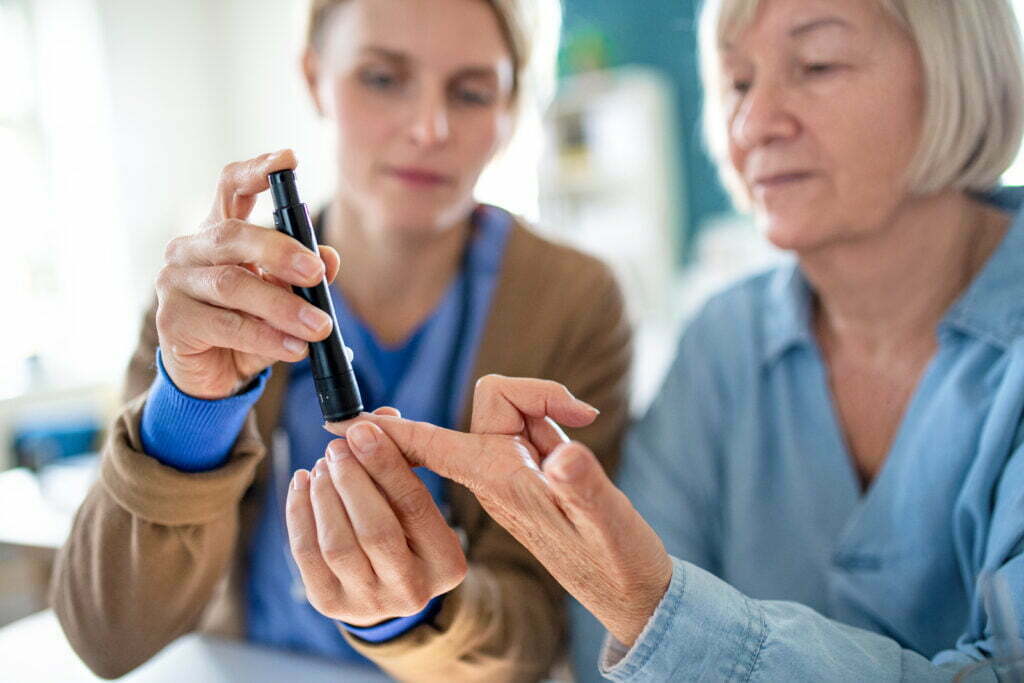Blood glucose control is the cornerstone of management in Diabetes. Many people with Diabetes, especially those receiving insulin therapy, use blood glucose monitors at home to track their blood glucose levels. According to the American Diabetes Association: “Glucose monitoring allows patients to evaluate their individual response to therapy and assess whether glycemic targets are being safely achieved. Integrating results into diabetes management can be a useful tool for guiding medical nutrition therapy and physical activity, preventing hypoglycemia, or adjusting medications.” Hence, accurate self-monitoring of blood glucose (SMBG) is essential to achieving excellent long term outcomes and avoiding complications for patients with Diabetes.
How typical glucose monitors work
Typical glucometers used in SMBG require a drop of capillary blood obtained by pricking the fingers. A drop of blood is placed on the test strip which contains an enzyme that subsequently reacts with the glucose in the blood sample. This reaction then produces a current proportional to the glucose level in the blood, which is then read by the glucometer as a corresponding glucose reading.
Basic steps in using glucose monitors
The basic steps in using typical finger-prick glucometers, according to the Centers for Disease Control and Prevention, are as follows:
- Make sure the meter is clean and ready to use.
- After removing a test strip, immediately close the test strip container tightly. Test strips can be damaged if they are exposed to moisture.
- Wash your hands with soap and warm water. Dry well. Massage your hand to get blood into your finger. Don’t use alcohol because it dries the skin too much.
- Place the strip in the meter. Use a lancet to prick your finger. Squeezing from the base of the finger, gently place a small amount of blood onto the test strip.
- After a few seconds, the reading will appear. Track and record your results. Add notes about anything that might have made the reading out of your target range, such as food, activity, etc.
- Properly dispose the lancet and strip in a trash container.
- Do not share blood sugar monitoring equipment, such as lancets, with anyone, even other family members.
- Store test strips in the container provided. Do not expose them to moisture, extreme heat, or cold temperatures.
Factors that may affect accuracy of glucose monitors
Several factors may affect the accuracy and reliability of capillary blood glucose values obtained via SMBG. According to the Journal of Diabetes Science and Technology, these include human, meter-inherent, test-strip-inherent, environmental, physiological, and medication-related impact factors.
- Human: Incorrect use of glucometers is the most common cause of inaccuracies. Because glucometers analyze minute blood samples, even minor contamination with glucose containing fluids, such as fruit residue on the skin, may cause falsely high measurements. Patient education and proper handwashing can minimize this error.
- Meter-inherent: Besides the inherent specifications and features of the particular glucometer, errors such as improper insertion of test strips or low battery may also affect results.
- Test-strip-inherent: Variations between test strips and vials may occur during the manufacturing process. This can lead to a degree of inaccuracy and fluctuations between different glucose readings.
- Environment: Temperature and humidity can affect test strip readings. Heat causes falsely elevated results, while cold causes falsely low results. Rapid changes in temperature can also cause a lag in function of 15-30 mins. Improperly stored strips that are exposed to high humidity will also cause readings to be inaccurate. High altitude can also affect accuracy of blood glucose readings. Electromagnetic interference from mobile phones can also impact the accuracy of glucometer readings; hence keeping mobile phones at least 50 cm away may reduce this error.
- Physiological: Some physiological factors may impact the accuracy of glucose readings. Hypotension can lead to falsely low values. Low hematocrit levels frequently result in falsely elevated readings, while high hematocrit levels may show falsely decreased BG levels. High triglyceride levels may cause falsely low BG readings, while hyperuricemia may cause falsely high BG readings.
- Medications: Medications such as ascorbic acid, acetaminophen, dopamine, maltose and mannitol may potentially affect glucose measurements. For example, elevated acetaminophen levels may cause falsely elevated BG values.
Related article: RPM: The Key to Assisting Future Diabetes Patients
Takeaway
Accurate self-monitoring of blood glucose revolves around correct usage of the glucometer, proper handwashing and awareness of environmental and physiological factors, and is paramount to achieving excellent outcomes in patients living with Diabetes.
References









